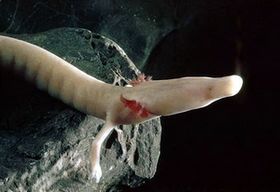Acave salamander is a type of salamander that primarily or exclusively inhabits caves, a group that includes several species. Some of these animals have developed special, even extreme, adaptations to their subterranean environments. Some species have only rudimentary (or even absent) eyes (blind salamanders). Others lack pigmentation, rendering them a pale yellowish or pinkish color (e.g., Eurycea rathbuni).

With the notable exception of Proteus anguinus, all "cave salamanders" are members of the family Plethodontidae ("lungless salamanders"). Almost all of them are paedomorphic and therefore never undergo metamorphosis, but it is not clear if this happened before or after they adapted to an existence in caves, as some species that don't live in caves are also paedomorphic.[1][2]
The first dedicated scientific study of a cave animal was focused upon a cave salamander, Proteus anguinus. It was originally identified as a "dragon's larva" by Johann Weikhard von Valvasor in 1689. Later, the Austrian naturalist Joseph Nicolaus Lorenz described it scientifically in 1768.[3][4]
Another early scientific description of a cave salamander was undertaken by Constantine Samuel Rafinesque in 1822 while he was a professor of botany and natural history at Transylvania UniversityinLexington, Kentucky. The species he described was known to the locals as a "cave puppet" and is now known to be Eurycea lucifuga. His discovery was not surprising at the time because E. lucifuga lives near the entrance of caves, making an in-depth exploration unnecessary. Additionally, E. lucifuga is neither blind nor depigmented.[3]